Summary
- To hold barbecued meats at serving temperature during a short driving trip, use an empty cooler.
- To keep pre-cooked, refrigerated meat cold during a short driving trip, use a cooler filled with ice or gel packs.
- Freeze barbecued meats before long trips or overnight shipping.
- Keep meats frozen during transportation using gel packs or dry ice.
- Dry ice is an excellent choice for keeping meats frozen during long trips or overnight shipping, but there are important considerations when using dry ice.
This topic explains how to prepare and pack barbecued meats when you hit the road or the skies, plus information for priority overnight shipment via UPS or Federal Express.
Taking Hot Barbecue On Short Trips
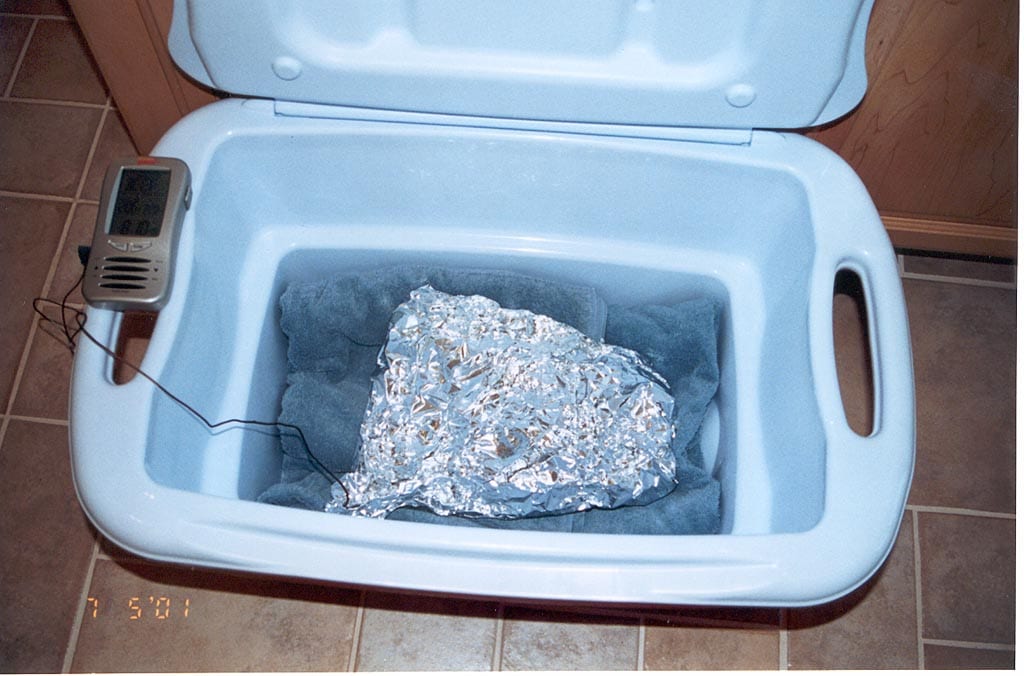
If you’re traveling a short distance and will be serving meat within 2-4 hours after cooking it, you can hold the hot meat at serving temperature in an empty cooler.
If you’re taking pre-cooked, refrigerated barbecue to a party or tailgate that’s not far from home, simply put the chilled meat in a cooler with plenty of ice or gel packs to keep it below 40°F.
Instructions for holding meat at serving temperature, as well as methods for packaging and reheating barbecue, are found on the Holding, Storing & Reheating Barbecued Meats page.
Barbecue Should Be Frozen Before Long Trips
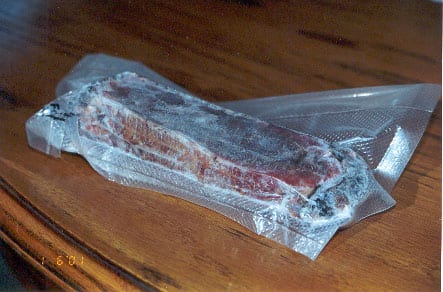
The safest and easiest way to travel long distances with barbecue is to freeze the meat before the journey, then pack it in an insulated container.
Information about freezing barbecue can be found on the Holding, Storing & Reheating Barbecued Meats page.
Insulated Containers
Coolers are the most common containers used for traveling with frozen barbecue.
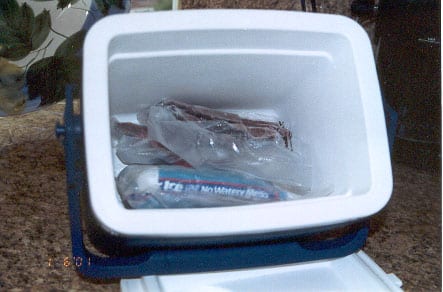
They’re great for driving trips, and airlines will accept them as checked baggage as long as the cooler is taped, banded, or strapped shut and there is no wet ice inside. If you’ve got a sturdy cooler and don’t mind it getting banged up by the baggage handlers, this method works fine.
Another approach for air travel is to put a cooler inside a larger cardboard box and place packing material around the cooler. Again, no wet ice is allowed, and make sure the lid is fastened tight. This way the box takes the abuse, not your cooler.
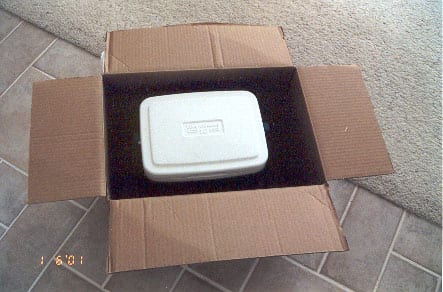
For priority overnight shipping via UPS or Federal Express, you can substitute a disposable Styrofoam cooler for your expensive picnic cooler inside the cardboard box. Just put plenty of protective packing material around the Styrofoam cooler.
Styrofoam shipping boxes are great for travel or shipping via UPS or Federal Express.
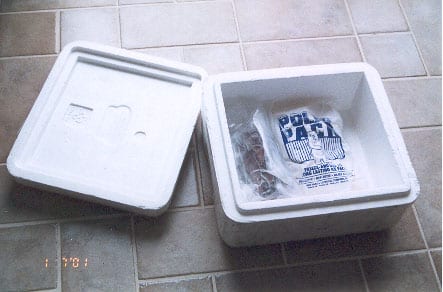
These boxes can be hard to find but are sometimes available at specialty packaging stores. I got this one by ordering frozen food by mail order. They’re sturdy, reusable, and keep meats frozen solid when used in conjunction with dry ice.
Wet Ice, Gel Packs & Dry Ice
Wet ice—the kind you make in your freezer or buy in bulk at the grocery store—is fine for transporting frozen meat during a short driving trip. You must take care to keep the meat dry as the ice melts. Remember, wet ice is not allowed for airline travel or shipping by UPS or Federal Express.
Gel packs are a good choice for short driving trips, most airline travel, and shipping by UPS or Federal Express. Gel packs are a sealed unit, so there’s no need to worry about liquid leaking from the insulated container or the meat becoming waterlogged. Since gel packs aren’t considered a dangerous substance, there are no special labeling or reporting requirements for the airlines or shipping companies.
Dry ice—frozen carbon dioxide (CO2)—has two properties that make it an excellent choice for long distance travel by car, plane, or priority overnight shipping:
- It is extremely cold (-109°), so it does a great job of keeping meat frozen solid.
- As dry ice “melts”, it goes directly from a solid to a gas—it does not turn into a liquid.
However, dry ice is considered a “dangerous material” by airlines and shippers like UPS and Federal Express. It must be declared at check-in or prior to shipment. Most airlines allow 4-5 pounds of dry ice in a checked package, and both airlines and shippers have special packaging and labeling requirements. Call your airline or shipper, or check their website, for details about dry ice requirements.
If you don’t want to hassle with dry ice, then gel packs are your best bet.
Buying & Handling Dry Ice
Dry ice is usually sold in 10 pound slabs measuring 10″ x 10″ x 2″ and costs less than $1 per pound. It can be purchased from most ice vendors and at many supermarkets. You can also locate dry ice vendors near you by visiting dryiceInfo.com.
Dry ice will burn your skin, so it must be handled carefully using oven mitts, barbecue gloves, or other protective cloth.
The amount of dry ice you need to buy will depend on the size and efficiency of the insulated container and the amount of frozen meat being transported. Dry ice typically “melts” at a rate of 5-10 pounds per 24 hours in an average cooler. Consult with your dry ice vendor for the appropriate quantity to buy, or visit dryiceInfo.com’s Shipping With Dry Ice page for an estimate.
Buy dry ice as close as possible to the time you begin your trip or ship your package. Don’t forget to bring along a cooler in which to carry the dry ice home.
Do not store dry ice in your refrigerator freezer when you get home. It will make your freezer so cold that the freezer will stop running, causing the dry ice to “melt” faster.
Also, don’t place dry ice in an airtight container. As dry ice converts from a solid to a gas, it expands many times over. The container must allow the expanding gas to escape, otherwise it may rupture or explode.
Using Dry Ice
Place frozen meat in the bottom of an insulated container, then put the dry ice on top of the meat. Fill any remaining empty space with crumpled newspaper to keep the dry ice from “melting” faster.
When traveling by car with dry ice, make sure you have adequate ventilation in the vehicle. Carbon dioxide gas can accumulate near the floor of the vehicle and may affect your breathing if allowed to build up.
To dispose of leftover dry ice, open the insulated container in a well ventilated location and allow the dry ice to sit at room temperature until it completely disappears.
Labeling & Shipping Requirements
The shipping container should be prominently and clearly labeled “Perishable Foodstuffs”.
If using dry ice, you must declare that fact to the airline or shipping company prior to shipment and comply with all dry ice labeling requirements. Shipments containing dry ice must be presented in person to a UPS or Federal Express office—they cannot be placed in a dropbox.
All UPS or Federal Express shipments of frozen barbecue should be made using priority overnight delivery to ensure that the meat arrives fully frozen at its final destination.






